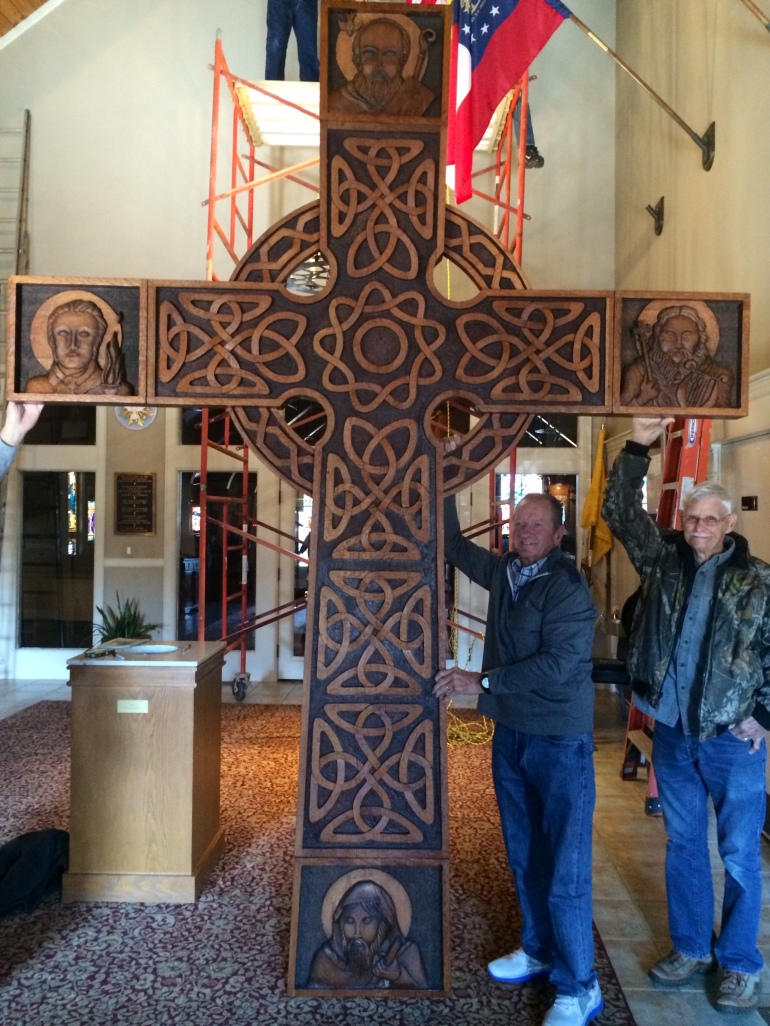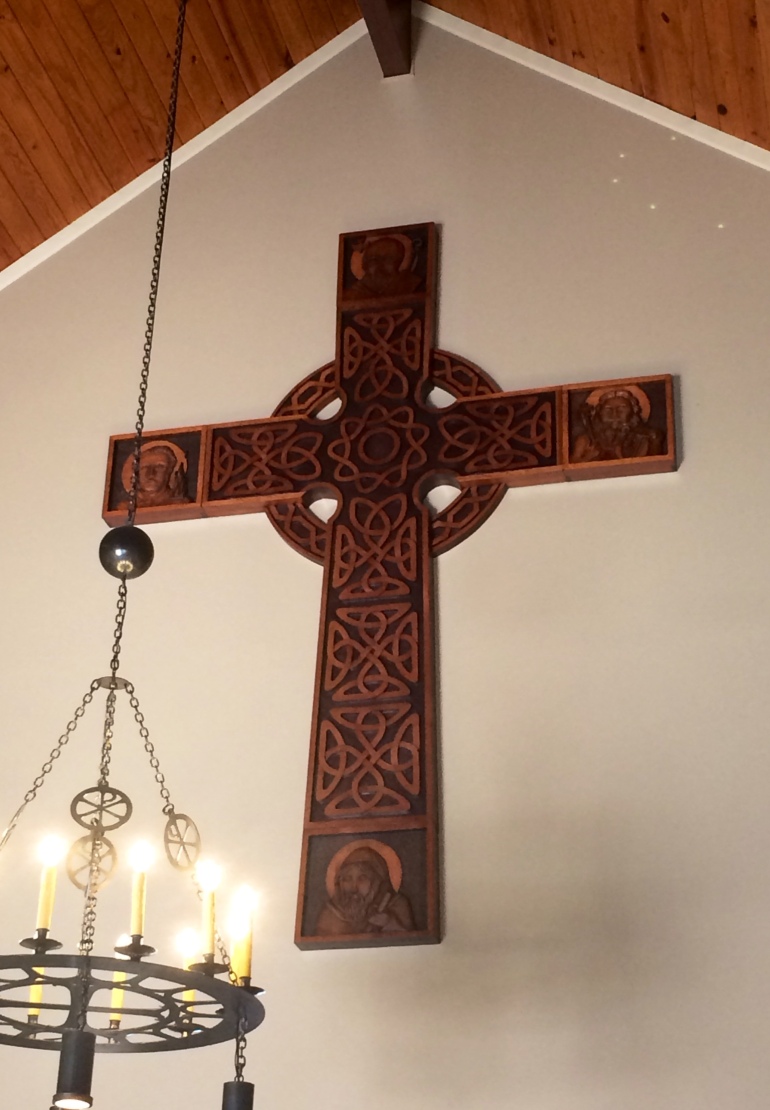by Daniel Mckeon
The narthex of Our Lady of the Mountains Parish in Jasper, Georgia will soon be adorned with a High Celtic cross sponsored by Knights of Columbus Council 14348. Carved and crafted by former parishioner and Knights of Columbus member John Roger, nearly twelve foot high cross will be placed above the doors entering the nave of the church. The cross exhibits the beautiful detailing unique and endearing to Celtic art, featuring woven patterns and bearing the images of four Celtic saints. “High Crosses like these were carved by missionaries of old who went forth from places like the Holy Island of Iona to preach the Gospel in what some have called the Dark Ages,” Pastor Father Charles Byrd explains. The four Irish saints to be immortalized on the four corners of the cross are Saint Finnian of Clonard, Saint Columba of Iona, Saint Aiden of Lindisfarne, and Saint Dallan Forgaill. However obscure they may seem, the extant information about these saints is testimony to their apostolic zeal and their valorous love of Christ.

The bas-relief on the base of the cross will be that of Saint Finnian. Born in 470 A.D. in County Carlow, Finnian was educated in Gaul and went on to found several churches and abbeys. Most notable among these was the Abbey at Clonard in County Mealth. Here, Finnian earned a reputation for his wisdom and holiness. This reputation inspired thousands across Europe to come and learn from the wise and holy Saint of Clonard. One of Finnian’s students was Saint Columba, the saint whose image graces the crest of the cross.
Columba’s name in Gaelic means “Church Dove.” As such, he is depicted with a dove in the bas-relief, the traditional symbol for the Holy Spirit, which he brought bravely through out the British Isles and, via his pupils, Europe and the world. A descendant of kings, Columba was born in 521 in County Donagal. He joined the monastery and studied under Finnian, becoming a tireless scribe, transcribing over 300 books. In 563, Saint Columba travelled with twelve companions in a wooden frame boat of wicker and leather to the island Iona, located near Scotland. On Iona, he established an abbey that become famous through out the world for its holiness and instruction.
On the right arm of the cross is the image of Saint Aidan of Lindisfarne. Like Finnian and Columba, Aidan was born in Ireland around 590 A.D. Early in his life he became a monk, entering the abbey on Iona. When Prince Oswald of Northumbria became king, he invited missionaries from the renowned Iona abbey to evangelize his kingdom. Previously, Oswald had studied with the monks at Iona while in exile. Aidan was among the missionaries requested by Oswald. Through out his life, Aidan founded many monasteries, churches, and schools, all of which became centers for learning and charity. Saint Aidan was known for taking in orphans and educating them. He was also known to pay the ransom to liberate slaves, who would later be ordained as priests. Aidan’s efforts endure today in the mission of the Knights of Columbus, to assist orphans and those in need, and the Knights’ incessant efforts to support the essential vocation of the priesthood. Aidan is depicted on the cross with a “flame,” the Gaelic meaning of his name. But the flame, of course, is more than an allusion to the saint’s Gaelic roots; in Christian symbolism, the flame represents the light of Christ, which Aidan brought through his works to the people of the British Isles, and illuminated the shadowy corridors of the so-called Dark Ages.
Like the sublime beauty of the Mass, the High Cross finishes with a hymn. The final image is that of poet and bard Saint Dallan Forgail, famous for his poem, “Be Thou my Vision,” which provides the words for one of the Church’s most enduring hymns. Descended from a high king of Ireland, Dallan was born in 530 A.D into a family of poets and saints. He was known for his holiness and verse. Dallan was eventually recognized as Chief Ollan of Ireland, a position described as a combination of poet laureate and minister of education. As Ollan (which means “most great”), it was Dallan’s responsibility to tell the tales of old, likely harkening back to the pagan days. But tragedy struck the saint in 598, when Dallan was beheaded by pirates raiding his island monastery of Inneskeel. His demise was now the subject of tales told by the bards that survived, similar to the ones he once told. Dallan was blind, which some say was the result of reading too many books. In fact, his name in Gaelic means, “Little Blind One.” His image on the cross depicts him as such.
Writer Thomas Cahill once quipped that Saint Patrick’s greatest gift to Ireland was the gift of Christianity, a gift we have seen multiplied a hundredfold over the centuries and particularly in these four Irish saints. Once installed, the High Cross will be a reminder of the example of these four saints and the sacrifices they made to sow the seeds of Christ’s love through out the world and across the ages. The cross is also a reminder that, at a time when the number of Christians being persecuted is growing incrementally and our Faith is increasingly under attack, Christ is our Light illuminating our way through these morally dark times, through this culture of death. It is a reminder in these times to “Be not afraid” and know, as Saint Dallan reminds the faithful of the world, that what e’er befall Christ must still be our vision.

_________________________________________________________________
Pontifex University is an online university offering a Master’s Degree in Sacred Arts. For more information visit the website at www.pontifex.university




